6 Chapter 6: Progressivism
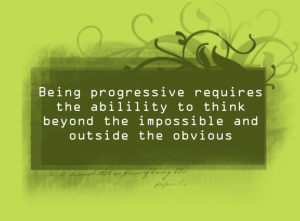
This chapter will provide a comprehensive overview of Progressivism. This philosophy of education is rooted in the philosophy of pragmatism. Unlike Perennialism, which emphasizes a universal truth, progressivism favors “human experience as the basis for knowledge rather than authority” (Johnson et. al., 2011, p. 114). By focusing on human experience as the basis for knowledge, this philosophy of education shifts the focus of educational theory from school to student.
In order to understand the implications of this shift, an overview of the key characteristics of Progressivism will be provided in section one of this chapter. Information related to the curriculum, instructional methods, the role of the teacher, and the role of the learner will be presented in section two and three. Finally, key educators within progressivism and their contributions are presented in section four.
Characteristics of Progressivim
6.1 Essential Questions
By the end of this section, the following Essential Questions will be answered:
- In which school of thought is Progressivism rooted?
- What is the educational focus of Progressivism?
- What do Progressivist believe are the primary goals of schooling?
Progressivism is a very student-centered philosophy of education. Rooted in pragmatism, the educational focus of progressivism is on engaging students in real-world problem- solving activities in a democratic and cooperative learning environment (Webb et. al., 2010). In order to solve these problems, students apply the scientific method. This ensures that they are actively engaged in the learning process as well as taking a practical approach to finding answers to real-world problems.
Progressivism was established in the mid-1920s and continued to be one of the most influential philosophies of education through the mid-1950s. One of the primary reasons for this is that a main tenet of progressivism is for the school to improve society. This was supposed to be achieved by engaging students in tasks related to real-world problem-solving. As a result, Progressivism was deemed to be a working model of democracy (Webb et. al., 2010).
6.2 A Closer Look
Please read the following article for more information on progressivism: Progressive education: Why it’s hard to beat, but also hard to find.
As you read the article, think about the following Questions to Consider:
- How does the author define progressive education?
- What does the author say progressive education is not?
- What elements of progressivism make sense, according to the author?Progressive education: Why it’s hard to beat, but also hard to find
Curriculum
6.3 Essential Questions
By the end of this section, the following Essential Questions will be answered:
- How is a Progressivist curriculum best described?
- What subjects are included in a Progressivist curriculum?
- Do you think the focus of this curriculum is beneficial for students? Why or why not?
As previously stated, Progressivism focuses on real-world problem-solving activities. Consequently, the Progressivist curriculum is focused on providing students with real-world experiences that are meaningful and relevant to them rather than rigid subject-matter content.
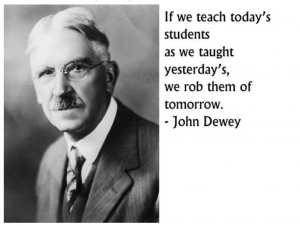
Dewey (1963), who is often referred to as the “father of progressive education,” believed that all aspects of study (i.e., arithmetic, history, geography, etc.) need to be linked to materials based on students every- day life-experiences.
However, Dewey (1938) cautioned that not all experiences are equal:
The belief that all genuine education comes
about through experience does not mean that
all experiences are genuinely or equally
educative. Experience and education cannot
be directly equated to each other. For some
experiences are mis-educative. Any experience
is mis-education that has the effect of arresting
or distorting the growth or further experience
(p. 25).
An example of miseducation would be that of a bank robber. He or she many learn from the experience of robbing a bank, but this experience can not be equated with that of a student learning to apply a history concept to his or her real-world experiences.
Features of a Progressive Curriculum
There are several key features that distinguish a progressive curriculum. According to Lerner (1962), some of the key features of a progressive curriculum include:

-
- A focus on the student
- A focus on peers
- An emphasis on growth
- Action centered
- Process and change centered
- Equality centered
- Community centered
To successfully apply these features, a progressive curriculum would feature an open classroom environment. In this type of environment, students would “spend considerable time in direct contact with the community or cultural surroundings beyond the confines of the classroom or school” (Webb et. al., 2010, p. 74). For example, if students in Kansas were studying Brown v. Board of Education in their history class, they might visit the Brown v. Board of Education National Historic Site in Topeka. By visiting the National Historic Site, students are no longer just studying something from the past, they are learning about history in a way that is meaningful and relevant to them today, which is essential in a Progressive curriculum.

- In what ways have you experienced elements of a Progressivist curriculum as a student?
- How might you implement a Progressivist curriculum as a future teacher?
- What challenges do you see in implementing a Progressivist curriculum and how might you overcome them?
Instruction in the Classroom
6.4 Essential Questions
By the end of this section, the following Essential Questions will be answered:
- What are the main methods of instruction in a Progressivist classroom?
- What is the teachers role in the classroom?
- What is the students role in the classroom?
- What strategies do students use in a Progressivist classrooms?

Within a Progressivist classroom, key instructional methods include: group work and the project method. Group work promotes the experienced-centered focus of the Progressive philosophy. By giving students opportunities to work together, they not only learn critical skills related to cooperation, they are also able to engage in and develop projects that are meaningful and have relevance to their everyday lives.
Promoting the use of project work, centered around the scientific method, also helps students engage in critical thinking, problem solving, and deci- sion making (Webb et. al., 2010). More importantly, the application of the scientific method allows Progressivists to verify experience through investigation. Unlike Perennialists and Essentialists, who view the scientific method as a means of verifying the truth (Webb et. al., 2010).
Teachers Role
Progressivists view teachers as a facilitator in the classroom. As the facilitator, the teacher directs the students learning, but the students voice is just as important as that of the teacher. For this reason, progressive education is often equated with student-centered instruction.
To support students in finding their own voice, the teacher takes on the role of a guide. Since the student has such an important role in the learning, the teacher needs to guide the students in “learning how to learn” (Labaree, 2005, p. 277). In other words, they need to help students construct the skills they need to understand and process the content.
In order to do this successfully, the teacher needs to act as a collaborative partner. As a collaborative partner, the teachers works with the student to make group decisions about what will be learned, keeping in mind the ultimate out- comes that need to be obtained. The primary aim as a collaborative partner, according to Progressivists, is to help students “acquire the values of the democratic system” (Webb et. al., 2010, p. 75).
Some of the key instructional methods used by Progressivist teachers include:
- Promoting discovery and self-directly learning.
- Engaging students in active learning.

Collaboration: Teacher to Student - Integrating socially relevant themes.
- Promoting values of community, cooperation, tolerance, justice, and democratic equality.
- Encouraging the use of group activities.
- Promoting the application of projects to enhance learning.
- Engaging students in critical thinking.
- Challenging students to work on their problem solving skills.
- Developing decision making techniques.
- Utilizing cooperative learning strategies. (Webb et. al., 2010).
6.5 An Example in Practice
Watch the following video and see how many of the bulleted instructional methods you can identify! In addition, while watching the video, think about the following questions:
- Do you think you have the skills to be a Constructivist teacher? Why or why not?
- What qualities do you have that would make you good at applying a Progressivist approach in the classroom? What would you need to improve upon?
Based on the instructional methods demonstrated in the video, it is clear to see that progressivist teachers, as facilitators of students learning, are encouraged to help their students construct their own understanding by taking an active role in the learning process. Therefore, one of the most com- mon labels used to define this entire approach to education today is: Constructivism.
Students Role
Students in a Progressivist classroom are empowered to take a more active role in the learning process. In fact, they are encourage to actively construct their knowledge and understanding by:
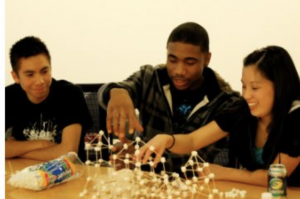
- Interacting with their environment.
- Setting objectives for their own learning.
- Working together to solve problems.
- Learning by doing.
- Engaging in cooperative problem solving.
- Establishing classroom rules.
- Evaluating ideas.
- Testing ideas.
The examples above clearly demonstrate that in the Progressive classroom, the students role is that of an active learner.
6.6 An Example in Practice
Mrs. Espenoza is an 6th grade teacher at Franklin Elementary. She has 24 students in her class. Half of her students are from diverse cultural backgrounds and are receiving free and reduced lunch. In order to actively engage her students in the learning process, Mrs. Espenoza does not use traditional textbooks in her classroom. Instead, she uses more real-world resources and technology that goes beyond the four walls of the classroom. In order to actively engage her students in the learning process, she seeks out members of the community to be guest presenters in her classroom as she believes this provides her students with an way to interact with/learn about their community. Mrs. Espenoza also believes it is important for students to construct their own learning, so she emphasizes: cooperative problem solving, project-based learning, and critical thinking.
6.7 A Closer Look
For more information about Progressivism, please watch the following videos. As you watch the videos, please use the “Questions to Consider” as a way to reflect on and monitor your own learnings.
- What are two new insights you gain about the Progressivist philosophy from the first video?
- What is the role of the Progressivist teacher according to the second video? Do you think you would be good in this role? Why or why not?
- How does Progessivism accommodate different learning styles? Give at least one specific example. What is the benefit of making this accommodation for the student?
- Can you relate elements of this philosophy to your own educational experiences? If so, how? If not, can you think of an example?
Key Educators
6.8 Essential Questions
By the end of this section, the following Essential Questions will be answered:
- Who were the key educators of Progressivism?
- What
impact did
each of the
key educators
of Progressivism have
on this philosophy
of education?
The father of progressive education is considered to be Francis W. Parker. Parker was the superintendent of schools in Quincy, Massachusetts, and later became the head of the Cook County Normal School in Chicago (Webb et. al., 2010). John Dewey is the American educator most commonly associated with progressivism. William H. Kilpatrick also played an important role in advancing progressivism. Each of these key educators, and their contributions, will be further explored in this section.
Francis W. Parker (1837 – 1902)
Francis W. Parker was the superintendent of schools in Quincy, Massachusetts (Webb, 2010). Between 1875 – 1879, Parker developed the Quincy plan and implemented an experimental program based on “meaningful learning and active understanding of concepts” (Schugurensky, 2002, p. 1). When test results showed that students in Quincy schools outperformed the rest of the school children in Massachusetts, the progressive movement began.

Based on the popularity of his approach, Parker founded the Parker School in 1901. The Parker School
“promoted a more holistic and social approach, following Francis W. Parker’s beliefs that education should include the complete development of an individual (mental, physical, and moral) and that education could develop students into active, democratic citizens and lifelong learners” (Schugurensky, 2002, p. 2).
Parker’s student-centered approach was a dramatic change from the prescribed curricula that focused on rote memorization and rigid student disciple. However, the success of the Parker School could not be disregarded. Alumni of the school were applying what they learned to improve their community and promote a more democratic society.
John Dewey (1859 – 1952)
John Dewey’s approach to Progressivism is best articulated in his book: The School and Society
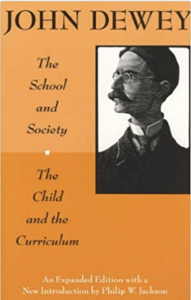
(1915). In this book, he argued that America needed new educational systems based on “the larger whole of social life” (Dewey, 1915, p. 66). In order to achieve this, Dewey proposed actively engaging students in inquiry-based learning and experimentation to promote active learning and growth among students.
As a result of his work, Dewey set the foundation for approaching teaching and learning from a student-driven perspective. Meaningful activities and projects that actively engaging the students’ interests and backgrounds as the “means” to learning were key (Tremmel, 2010, p. 126). In this way, the students could more fully develop as learning would be more meaningful to them.
6.9 A Closer Look
For more information about Dewey and his views on education, please read the following article titled: My Pedagogic Creed. This article is considered Dewey’s famous declaration concerning education as presented in five key articles that summarize his beliefs.
William H. Kilpatrick (1871-1965)
Kilpatrick is best known for advancing Progressive education as a result of his focus on experience-centered curriculum. Kilpatrick summarized his approach in a 1918 essay titled “The Project Method.” In this essay, Kilpatrick (1918) advocated for an educational approach that involves
“whole-hearted, purposeful activity proceeding in a social environment” (p. 320).
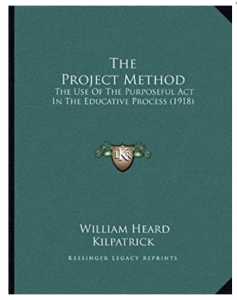
As identified within The Project Method, Kilpatrick (1918) emphasized the importance of looking at students’ interests as the basis for identifying curriculum and developing pedagogy. This student-centered approach was very significant at the time, as it moved away from the traditional approach of a more mandated curriculum and prescribed pedagogy.
Although many aspects of his student-centered approach were highly regarded, Kilpatrick was also criticized given the diminished importance of teachers in his approach in favor of the students interests and his “extreme ideas about student- centered action” (Tremmel, 2010, p. 131). Even Dewey felt that Kilpatrick did not place enough emphasis on the importance of the teacher and his or her collaborative role within the classroom.
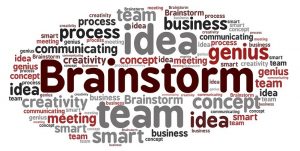
Reflect on your learnings about Progressivism! Create a T-chart and bullet the pros and cons of Progressivism. Based on your T-chart, do you think you could successfully apply this philosophy in your future classroom? Why or why not?
Media Attributions
- Progressivism Quote © quotemaster.org
- Dewey Curriculum © quotesgram.com
- Action Centered © Photos for Class
- Stop and Think © DWRose
- Project Based Learning © Blendspace
- Collaboration © photosforclass.com
- Learning by Doing © PBL Education - WordPress.com
- Francis W. Parker Quote © azquotes.com
- School and Society © Amazon.com
- The Project Method © Goodreads.com
- Brainstorm

